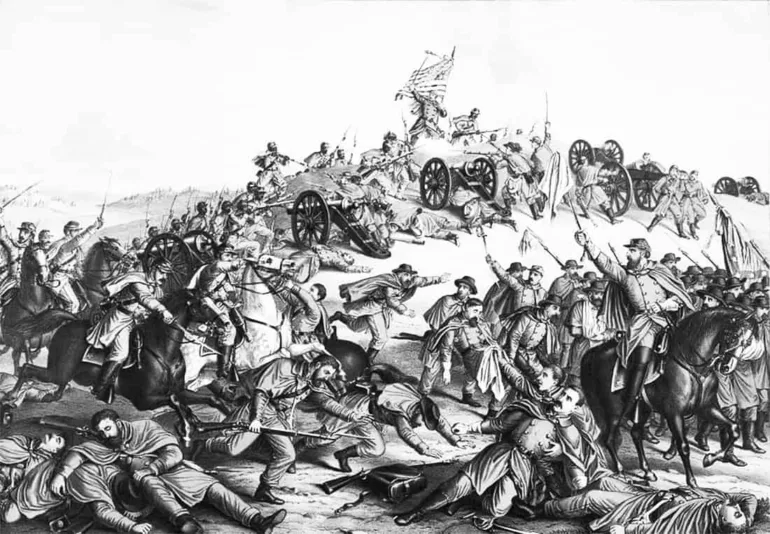Historian Markus Krueger remembers the day he learned about black Civil War hero Felix Battles.
Eight years ago, Krueger, programming director at the Historical and Cultural Society of Clay County, was researching the Civil War through U.S. Census records from the late 1800s. For a self-proclaimed “Civil War nerd,” this wasn’t uncommon.
He came across a different name, Luther Osborn, a white officer from Glyndon who fought with the United States Colored Troops (USCT) during the Civil War.USCT soldiers were primarily black Americans — often led by white officers — who accounted for more than 10 percent of the Union Army. It’s rare to find one from Minnesota.
Fascinated by his discovery, Krueger notified his colleague Mark Peihl, senior archivist at the HCSCC.
That’s when Peihl informed Krueger there was another USCT soldier from right here in Moorhead who he’s been researching for decades: Felix Battles.
Battles was one of 104 black Americans who joined the Union Army from Minnesota. As a corporal for the USCT, he fought in the pivotal Battle of Nashville in 1864, a victory that “took the Confederate Army out of the western theater of the Civil War,” Krueger says.
After the war, Battles made his way to Moorhead by working for the railroad and became one of the first pioneers to settle in the area in the 1870s. He owned a successful barbershop in town, which is likely how he earned the nickname, “the pioneer barber of the Red River Valley.”
The historians recently discovered Battles’ pension record, which offered a deeper glimpse into his humble life in Moorhead until his death in 1907.
Battles’ contributions to local and national history gave Krueger an idea to commemorate the unsung war hero with a steel monument in Moorhead.
“Felix falls into the category we have (in our community) of ‘ordinary people doing extraordinary things,’ ” Krueger says. “This monument will be an affirmation of the values that Felix, his fellow soldiers in the USCT and the Union soldiers in general fought and died for: the preservation of a nation of the people, by the people and for the people, based on the notion that everyone is created equal.”

The steel mock-up of Felix Battles, which is roughly three feet tall. The monument would stand at Battle’s height of 5 feet 8 inches. Photo courtesy of Markus Krueger/HCSCC.
Krueger used his artistic talents to create a stencil mock-up of the monument and has several locations in mind based on where Battles lived.
But it’s an idea he wants the community to get behind. That’s why he’s raising awareness about Felix Battles and inviting citizens to make small donations toward the $1,000 project so they can take ownership of the monument, Krueger says.
“I hope in 20 years, there’s going to be a guy who points to (the monument) and tells his kid, ‘I helped make that,’ ” he says.
Krueger’s first presentation on Felix Battles takes place at 6 p.m. Monday, May 7 at Junkyard Brewing Company.
Krueger hopes to have the monument installed by next winter and plans to continue presenting about Battles to shed light on his fascinating life, as his story and others like it “have been intentionally and systematically overlooked or erased,” he says.

Battles owned a successful barbershop in the Jay Cooke Hotel on the corner of 8th Street and Center Avenue in Moorhead. Photo courtesy of the HCSCC.
Much of what Krueger knows about Battles stems from Peihl’s research from the past 30 years.
Battles was born into slavery in Memphis, Tennessee, in the early 1840s on a cotton plantation. He was worth three pianos, or $600, as a young slave.
By the time the Civil War broke out, Battles was documented as a free man living in the Midwest, Peihl says.
“I would love to know how (he escaped slavery), but we just don’t know,” he says. “When you’re trying to piece together someone’s life story from the paper trails they leave behind, there are always huge gaps.”
It’s especially difficult to find records of specific black Americans before the war because “they were purposely dehumanized,” Krueger says. He adds that there is no known photo of Felix Battles. He created the monument mock-up from a photo of a different unnamed USCT soldier.

Because there’s no known photo of Felix Battles, Krueger created the monument mock-up from a photo of a different unnamed USCT soldier. Photo courtesy of the HCSCC.
That means Battles intentionally joined the fight to free other people, which is why he deserves to be recognized, Krueger says.
“It’s time to tell his story.”
To learn more about Felix Battles, the USCT and how to donate to the monument, visit hcscconline.org/felixbattles.
This article is part of a content partnership with the Fargo Forum and originally appeared in print on Monday, May 7, 2018.
